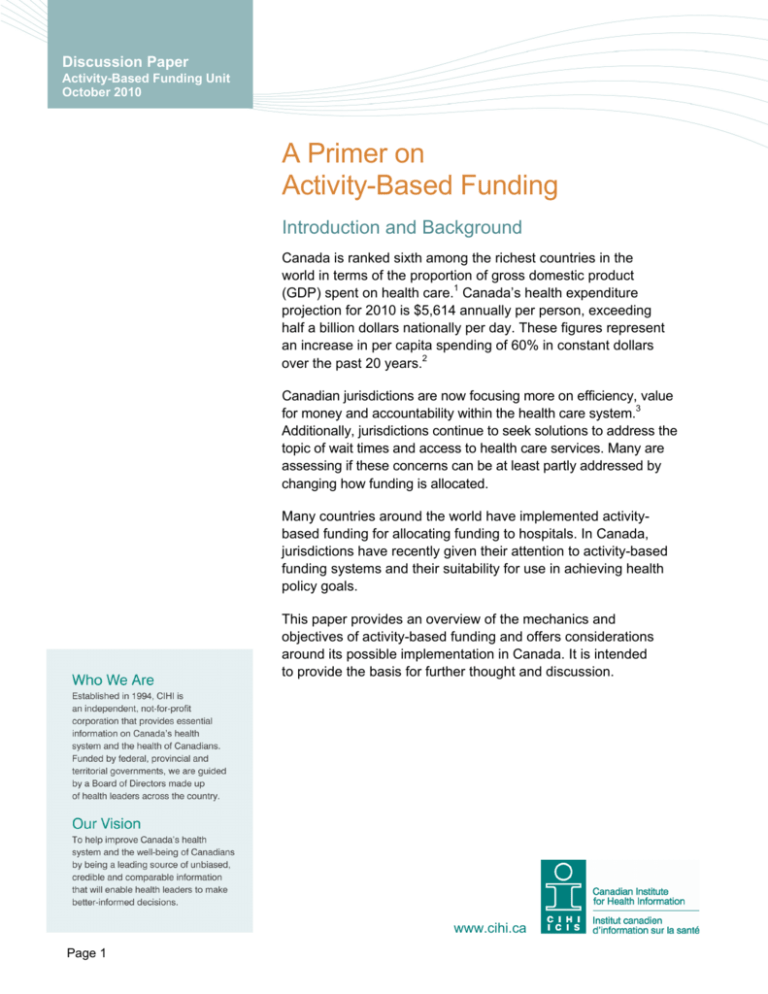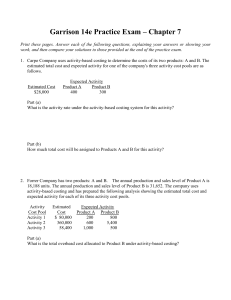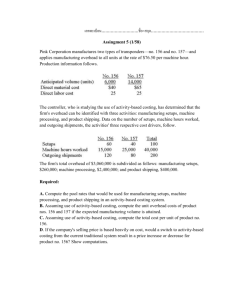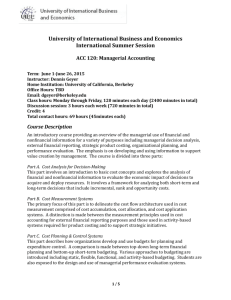A Primer Activity-Based Funding
advertisement

Discussion Paper Activity-Based Funding Unit October 2010 A Primer on Activity-Based Funding Introduction and Background Canada is ranked sixth among the richest countries in the world in terms of the proportion of gross domestic product (GDP) spent on health care.1 Canada’s health expenditure projection for 2010 is $5,614 annually per person, exceeding half a billion dollars nationally per day. These figures represent an increase in per capita spending of 60% in constant dollars over the past 20 years.2 Canadian jurisdictions are now focusing more on efficiency, value for money and accountability within the health care system.3 Additionally, jurisdictions continue to seek solutions to address the topic of wait times and access to health care services. Many are assessing if these concerns can be at least partly addressed by changing how funding is allocated. Many countries around the world have implemented activitybased funding for allocating funding to hospitals. In Canada, jurisdictions have recently given their attention to activity-based funding systems and their suitability for use in achieving health policy goals. This paper provides an overview of the mechanics and objectives of activity-based funding and offers considerations around its possible implementation in Canada. It is intended to provide the basis for further thought and discussion. www.cihi.ca Page 1 Discussion Paper Activity-Based Funding Unit October 2010 Case Mix Systems Activity-based funding relies heavily on the use of case mix systems. Therefore, it is important to understand the design of case mix systems prior to introducing activity-based funding. Case mix systems have a function that is similar to other classification systems: they condense an extremely large number of seemingly unique items—here, patient episodes—to a limited number of groups that have certain clinical characteristics in common.4 Episode-based case mix systems categorize patient episodes into usable groups so the episodes within any case mix group are clinically similar and consume similar health care resources. These are powerful tools for hospital administrators, as they enable patient episodes to be summarized in both clinical and financial terms. Some key design criteria of a case mix system are the following: • It needs to be based on data inputs that are complete and reliable; • Assignment of a case mix group and a cost weight to an episode needs to be widely accepted, transparent and have face validity; • Case mix groups need to be homogeneous, both clinically and in terms of cost; and • It must allow for timely implementation, monitoring, evaluation and updating. Case mix systems work as follows: patient-level clinical data (such as most responsible diagnosis, intervention, comorbidity and age) for each patient episode (that is, each hospital stay) is fed into the case mix system and is used to assign a case mix group to each patient episode. Most case mix systems also assign a cost measure to each episode. This cost measure is either the average dollar cost of episodes within the case mix group to which it was assigned or a relative cost weight. For cost weights, the average cost of all episodes across all case mix groups is set as the reference point, typically represented by a cost weight of 1. The cost weight for each case mix group, and each patient episode assigned to that case mix group, is then set relative to that reference point. That is, the cost weight assigned to an episode represents its cost relative to the average cost of all episodes across all case mix groups. As an example, a cost weight of 0.5 is assigned to an episode that consumes half the resources of the average episode, whereas a cost weight of 2 is assigned to an episode that consumes twice the resources. Cost weights explain the variability in costs due to clinical differences alone. They do not take into account variations in costs across hospitals that result from structural effects such as size, tertiary care focus, isolation or teaching activities. In the discussion that follows, it is important to keep in mind that case mix systems were not initially developed specifically for funding. Rather, their original purpose was to be cost management tools to help clinicians and hospital administrators monitor quality of care and service utilization. Nonetheless, they have been used for additional purposes, including hospital budgeting and funding.5 Many developed countries have integrated case mix systems into funding models that determine reimbursement rates for certain patient populations—that is, activity-based funding.6 The attraction of using case mix systems for funding purposes is that they provide a means of categorizing patient episodes into payment groups and a measurement that approximates the cost for each episode. Page 2 Discussion Paper Activity-Based Funding Unit October 2010 Funding Hospitals in Canada—Global Budgets The majority of jurisdictions in Canada fund their health care systems using global budgets—the system funding total and its allocation across hospitals is set at the beginning of the fiscal year. The funding levels and allocations may be adjusted over time—using socio-demographic, political and economic factors to determine future payments7—but mainly follow historic patterns. As well, the global budget model may incorporate a target level of activity for the hospital. A deficiency of global budgets is that the allocation of funding among hospitals might not take into account the differences in the type and complexity of patients they treat. Certain modifications to global budgets have reduced the impact of this limitation. For example, case mix systems have been used to some extent in Canada and internationally to address inequities in global funding allocations by applying case mix adjustments that consider the distribution of weighted cases across hospitals. A hospital’s weighted cases is the sum of cost weights within that hospital. Other evidence-based adjustments to funding allocations might take into account differences in hospital characteristics that are known to affect costs. Difficulties also arise if hospitals fall short of or exceed target levels of activity. This can be addressed retrospectively through budgetary adjustments, which effectively act by imposing financial penalties on hospitals that underperform or by rewarding additional funds to hospitals that overperform.8 A more significant limitation of global budgets is their inability to support specific health policy objectives; while they do provide a means of limiting spending on the health care system, they do not provide incentives to improve quality of care or to increase the efficiency of hospital operations.9 Activity-Based Funding Defined Activity-based fundingi can be defined by two features: first, a case mix system is used to describe hospital activity and to define its products or outputs; second, a payment price is set for each case mix group in advance of the funding period and payments to the hospital are made on a per case basis.8 Activity-based funding shifts from the view that patient episodes are expenses incurred by a hospital to the view that patient episodes are revenue generators for a hospital. The principle here is that payments are determined for different patient groupings rather than for the specific services delivered. That is, reimbursement to hospitals is based on the approximate costs associated with treating a specific case. This way, hospitals are financially motivated to use the most appropriate means of care to treat patients, reduce the cost of treating patients and reduce unnecessarily long hospital stays.10 Payments for unnecessary services or to extend hospital stays longer than needed are no longer provided. i. Other funding models that share principles of activity-based funding include case mix funding, diagnosis-related group (DRG)–based funding, patient-focused funding, pay for performance (P4P), payment by results (PbR), prospective payment system (PPS) and service-based funding.9 Page 3 Discussion Paper Activity-Based Funding Unit October 2010 Case mix systems have been a fundamental component in implementing activity-based funding in other countries. Specifically, the basis used by other countries for setting payment rates is the cost weights from a case mix system. Although case mix systems have been found to be well-suited for this funding purpose, the methodology that generates case mix groups and cost weights must align with a jurisdiction’s health payment policies and goals. Some possible modifications of a case mix system used for funding include the following: • Focus on specific costs: If only certain expenses are to be paid through activity-based funding, then it is important that the cost weights used for setting prices comprise only those expenses. Cost weights used for activity-based funding may need to reflect the marginal cost of an additional episode or the cost of only specific components of care. • Redesign the case mix system: Changes may be needed to align the case mix system with a jurisdiction’s payment policy and may include modifying case mix groups or changing the cost weight methodologies. Payment Prices for Activity-Based Funding In pure activity-based funding, hospitals may be motivated to increase activity since each patient episode brings additional revenue. However, pure activity-based funding is rarely implemented for two reasons. First, certain allocations to the hospital, such as for teaching and research, are often considered unsuitable for reimbursement under activity-based funding. Second, a jurisdiction may need to establish activity targets and incorporate alternative pricing schemes for cases that exceed activity targets. The variation in allocation and activity mentioned above results in three activity-based funding models—pure, mixed and mixed with subsidiary pricing—as illustrated in Figure 1. Figure 1: Activity-Based Funding Models Page 4 Discussion Paper Activity-Based Funding Unit October 2010 While this figure may give the impression that activity-based funding is simple to implement, the complexity in this funding model is the integrated steps that determine the expenses that will be funded irrespective of activity levels (the intercept RF), the price per patient episode (the slope of the line), where to set a target level of activity (NT) and the post-target subsidiary price per patient episode (the change in the slope of the line). To obtain this information the following considerations need to be addressed. Establishing Activity-Level Targets Activity-level targets allow incentives to be moderated according to the amount of activity provided, as below-target payment rates can differ from above-target rates. If the above-target payment rate is less than the below-target payment rate, the jurisdiction is better situated to maintain control over total health expenditure. Alternately, if the jurisdiction aims to increase activity, the above-target payment rate can be higher, creating strong incentives for hospitals to take on additional work.8 Establishing where to place activity-level targets and how payment will be affected if targets are surpassed depends upon the policy goals of the jurisdiction. Defining the Scope of Hospital Activities Funded Under Activity-Based Funding Another consideration when implementing activity-based funding is to determine which hospital expenses are suitable for inclusion. Expenses that are incurred irrespective of activity may be excluded from activity-based funding and funded separately using a global budget; examples of these expenses are research, education, innovative activities, investments in infrastructure and maintaining emergency care capacity.11 Clinical considerations can also offer guidance in determining the scope of patient episodes to exclude from an activity-based funding model.6 For example, it may not be the desired funding model for mental health patients. Data quality issues with clinical data or cost data may result in further exclusions. Determining Predicted Costs for Patient Episodes Once the scope of services and episodes targeted for activity-based funding is defined, a cost weight for each episode needs to be accurately approximated. To produce cost weights that are meaningful for activity-based funding, there is a need for these weights to be based on only the scope of services and episodes that are eligible for inclusion. In addition, specific methodological changes to the case mix system may be needed that will affect cost weights. As an example, case mix systems look at the length of stay distribution of episodes within each case mix group and set a trim point for each group. An episode with a length of stay beyond the trim point of its group is considered to have an extraordinarily long length of stay that cannot be explained based on its clinical characteristics alone. A case mix system will commonly adjust the cost weight assigned to such an episode to provide a fairer sharing between the hospital and the jurisdiction of the cost of that episode. This adjustment is done using a per diem increment to the cost weight for each day of stay past the average length of stay. Setting trim points and the per diems needs to consider the jurisdiction’s health payment policy regarding fair reimbursement for these long-stay episodes. Page 5 Discussion Paper Activity-Based Funding Unit October 2010 Other factors that influence cost need to be addressed and accommodated in a payment rate, such as facility size, tertiary care focus, teaching activities and geographic location.6 These additional considerations need to be explored and addressed outside the case mix system; as noted earlier, cost weights are limited to explaining the variation in costs due to clinical factors alone. Determining When Payment Should Differ From Average Cost Setting payment rates to equal the average cost provides incentives for hospitals with above-average costs to reduce those costs. Payment rates that differ from average cost may be appropriate when specific changes in hospital behaviour are desired, such as strong incentives to improve efficiency in providing care, increase access to care or improve quality of care. Some examples of strategies to address different policy goals are the following: • The variation in costs across similar types of hospitals can reveal what is achievable in terms of hospital efficiency, although some important caveats must be addressed.12 For example, the payment rate for a case mix group might be set at a more challenging benchmark than the average cost, encouraging hospitals to become better than average in terms of efficiency.13 • Less expensive courses of treatment can be encouraged by adjusting payment rates. For example, an intervention performed in a day surgery setting, even if paid in excess of cost, can be less expensive than if it was performed in an inpatient setting, resulting in the incentive to move certain inpatient care to the day surgery setting.14 • For certain types of patient episodes, payments may exceed costs to give hospitals an incentive to provide the additional capacity needed to reduce wait lists.15 • Payments may not fully reimburse hospitals for expenses that should be avoidable if clinical best practice guidelines are followed.14 Measuring Success and Monitoring Effects on the Health Care System The implementation of activity-based funding is a sizable undertaking. It requires obtaining buy-in from hospital administrators, establishing appropriate information technology and administrative resources within the hospital and the funding organization, ensuring collaboration with other initiatives that aim to improve access to and quality of care, and having a vision that encourages system-wide improvements. To ensure that the funding model is achieving its desired outcomes, it is critical to develop measures that monitor the changes in hospital behaviours as a result of implementing activity-based funding. While the goal of any evidence-based funding model is to provide incentives for favourable changes in hospital behaviour, the true outcome may have unfavourable elements.10, 16 For this reason, monitoring effects and measuring success in behavioural changes are important components of the overall plan when introducing activity-based funding. Figure 2 explores changes in hospital behaviour that can result from implementing activity-based funding. Page 6 Discussion Paper Activity-Based Funding Unit October 2010 Increased efficiency and reduced cost per patient Increased access to health care and reduced wait times Increased patient satisfaction and quality of care Improved use of best clinical practices Improved coding quality in response to the relationship of complete and reliable clinical data to funding allocations Unfavourable Favourable Figure 2: Possible Favourable and Unfavourable Hospital Behaviour Changes Resulting From Activity-Based Funding Increased overall costs to the health care system in the absence of overall caps on spending More intensive or additional treatment where payment is higher than cost; conversely, appropriate treatment not provided where payment is lower than cost A shift in elective care to focus on clinical areas that are more profitable Inappropriate inpatient admissions for treatments historically offered in less expensive settings Premature discharges resulting in readmissions Reduced coding quality as a consequence of aims to influence the payment price In addition to observing changes within a hospital, jurisdictions must consider the effects of a funding model on the operations of the entire health care system. Changes in the interactions among hospitals and among health sectors can be monitored to determine if the changes are desirable in terms of quality of care or efficiency of health care resources. Metrics used to monitor changes in hospital behaviours may serve the purpose of penalizing poor quality of care and rewarding good quality of care. To this end, new approaches to collecting data may be needed. Patients may need to be solicited to truly understand their health outcomes, for example, by implementing and monitoring patient-reported outcome measures.17 Also, the authority that is responsible for clinical data collection may need to be independent from the hospital to ensure coding quality.14 If a jurisdiction decides to implement activity-based funding, it may consider an approach that redirects a small proportion of hospital global budgets toward activity-based funding and then progressively increases this proportion annually. The merit in this proposal can be found by reviewing the extent and speed of implementation of activity-based funding in other countries.8 Other options for introducing activity-based funding in Canada could be to implement it initially in only certain hospitals or for selected patient service categories. Phased implementation provides an opportunity to validate the new funding model while giving hospital administrators time to learn the new funding rules. Page 7 Discussion Paper Activity-Based Funding Unit October 2010 Concluding Remarks This paper has provided an overview of the mechanics and objectives of activity-based funding and some considerations in its design and implementation. While this discussion has focused on the application of activity-based funding to inpatient hospitalizations, similar applications apply to other health care settings. CIHI has established an Activity-Based Funding Unit to serve jurisdictions as a centre of technical expertise on the design, implementation, monitoring and evaluation of activity-based funding systems and the application of CIHI products in these systems. For more information on these or other related topics, contact us at casemix@cihi.ca. Page 8 Discussion Paper Activity-Based Funding Unit October 2010 References 1. Organisation for Economic Co-operation and Development, OECD Health Data 2010— Frequently Requested Data (Paris, France: OECD, 2010), accessed on September 28, 2010, from <http://www.oecd.org/document/16/0,3343,en_2649_34631_2085200_1_1_1_1,00.html>. 2. Canadian Institute for Health Information, National Health Expenditure Trends, 1975 to 2010 (Ottawa, Ont.: CIHI, 2010). 3. Canadian Institute for Health Information, Health Care in Canada 2009: A Decade in Review (Ottawa, Ont.: CIHI, 2009). 4. R. B. Fetter et al., “Case Mix Definition by Diagnosis-Related Groups,” Medical Care 18, 2 Suppl. (1980): pp. 1–53. 5. Canadian Institute for Health Information, CMG+ Tool Kit—Transitioning to the New CMG+ Grouping Methodology (Ottawa, Ont.: CIHI, 2007). 6. J. Schreyögg et al., “Methods to Determine Reimbursement Rates for Diagnosis Related Groups (DRG): A Comparison of Nine European Countries,” Health Care Management Science 9 (2006): pp. 215–223. 7. British Columbia Medical Association, Valuing Quality: Patient-Focused Funding in British Columbia (Vancouver, B.C.: BCMA, 2010). 8. A. Street et al., Introducing Activity-Based Financing: A Review of Experience in Australia, Denmark, Norway and Sweden (CHE Research Paper 30) (York, U.K.: Centre for Health Economics, 2007). 9. J. McAllister, “A Better Way of Funding Hospitals,” Canadian Healthcare Manager January/February (2010): pp. 17–21. 10. J. Cylus and R. Irwin, “The Challenges of Hospital Payment,” Euro Observer 12, 3 (2010): pp. 1–3. 11. D. Scheller-Kreinsen, A. Geissler and R. Busse, “The ABC of DRGs,” Euro Observer 11, 4 (2009): pp. 1–5. 12. K. Eagar, The Cost of Public Hospitals—Which State or Territory Is the Most Efficient? (ABF Information Series No. 4) (Wollongong, Australia: University of Wollongong, 2010), accessed on September 28, 2010, from <http://chsd.uow.edu.au/content/groups/public/@web/ @chsd/documents/doc/uow082636.pdf>. 13. S. J. Duckett, “Casemix Funding for Acute Hospital Inpatient Services in Australia,” Medical Journal of Australia 169 (1998): pp. S17–S21. 14. A. Street and A. Maynard, “Activity Based Financing in England: The Need for Continual Refinement of Payment by Results,” Health Economics, Policy and Law 2 (2007): pp. 419–427. Page 9 Discussion Paper Activity-Based Funding Unit October 2010 15. A. Street and S. J. Duckett, “Are Waiting Lists Inevitable?,” Health Policy 36 (1996): pp. 1–15. 16. Z. Or, “Activity Based Payment in France,” Euro Observer 11, 4 (2009): pp. 5–6. 17. S. J. Duckett, “Hospital Payment Arrangements to Encourage Efficiency: The Case of Victoria, Australia,” Health Policy 34 (1995): pp. 113–134. Page 10









